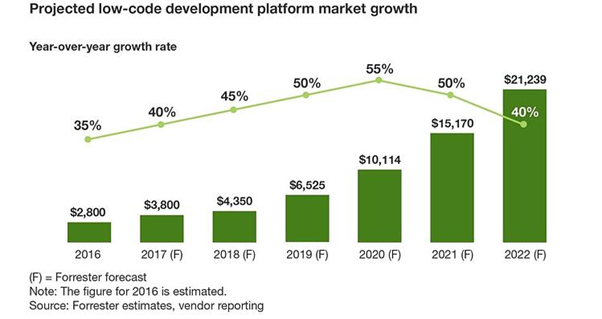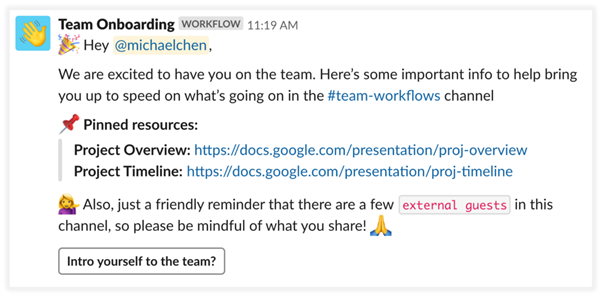Forget the traditional image of the computer programmer typing at 100 miles an hour, tapping out streams of neon green code, to finally exclaim "I'm in". You, instead, are the rugged ex-military super spy in a leather jacket, spitting back "In English, Goddammit!" Much, much cooler.

So, let's jump into why you've been hearing the words "low-code/no-code" so frequently from marketers. Well:
- Forrester expects the no-code/low-code market to reach a staggering $21.2 Billion by 2022.
- Gartner estimates that enterprise low-code application platforms (LCAP) will be 65% of all app creations within the next five years.
- Inside Big Data reports that the mixture of low-code and conventional innovation is projected to be adopted by 75% of businesses
…and what's the difference between the two, I hear you ask?
- No-code. In the no-code space, citizen developers build functional, but limited apps, without the need to write a single line of code.
- Low-code. Low code requires a small amount of coding skill, focusing more on professional IT developers. This movement allows individuals to create enterprise-class apps without going through the entire coding process, using pre-written code to accelerate production.
Looking for the down low from a download? Want to be overly-informed on No Code/ Low Code? Well, check out our No Code/ Low Code Best Practice Guide, here!
Both the low-code and no-code landscape is complex, with multiple platforms, submarkets and solutions. Just take a look at Gartner's Magic Quadrant for enterprise low-code platforms:
Gartner defines a low-code application platform (LCAP) as “an application platform that supports rapid application development, one-step deployment, execution and management using declarative, high-level programming abstractions, such as model-driven and metadata-based programming languages.”
So, in an era where digital transformation and innovation play a critical role in organisational growth, the speed, accessibility, and automation that low-code and no-code can provide can mean the difference between being at the front and the back of the pack.
But, let's take a deeper look.
You get digital transformation, and you get digital transformation! And you get digital transformation!
Thanks, Oprah.
No-code and low-code tools make development accessible, putting user-friendly features, like drag-and-drop interfaces and WYSIWYG editors, into the hands of citizen engineers.
This means non-developers from HR, marketing, and ops teams can deploy successful and impactful software applications quickly. Plus, it's not just about deployment. These teams can also maintain the software - no need for hours waiting around for an engineer.
It's all about lowering the technical barriers between teams.
It's not just citizen engineers who can benefit, oh no. According to Shiven Ramji, chief product officer for Auth0:
“Giving more teams the autonomy to contribute to app development with low code and no code saves valuable resources, and will continue to lower the barrier to entry for building stellar apps,”
Finally, there is a big focus on low code and no code as being a big benefit to non-developer audiences, but let’s not forget that not all developers actually want to write or own code that could easily be accomplished by a low-code or no-code solution. So this is a win for both developer and non-developer audiences.”
So, it's no surprise low-code and no-code tools, which some dismissed as a 'trend' a few years ago, have been adopted rapidly across multiple industries.

Now that companies find themselves in the middle of a "developer drought", recruiting effective software solutions is vital. So, businesses are seeing their way out of this conundrum with low-code/no-code solutions. Let's have a look into some more benefits.
Low Code, No Code, Fo' So.
Speed.
Speed is another benefit of the no-code/low-code approach.
"Digital transformation has been a high priority for years but the COVID pandemic took the importance of digital transformation to a new level," said Josh Kahn, senior vice president of creator workflow products at ServiceNow. "The speed at which companies need to deliver new applications to digitize business processes has never been faster.”
Low code also helps speed up the delivery of apps in a couple of different ways. This can include IT developers using low-code tools to generate the simple parts, so they can spend their time on coding. Another way can mean moving the app development beyond the, often overworked, IT development organisation.
Sharing Skills.
Historically, only a small percentage of people were able to create software.
"We are seeing adoption of low-code across many different job titles, from people with obvious adjacent skill sets like data analysts and electrical engineers to perhaps more surprising roles like attorneys and underwriters," says Sheryl Koenigsberg, head of global product marketing at Mendix.
"People with this kind of very specific domain expertise can meaningfully contribute to the delivery of software. Not only are they able to create their own workgroup apps for things like forms and simple workflows, but they can also co-create enterprise solutions alongside professional developers. As we discussed previously, our platform's thoughtful governance model allows for this type of work, which is otherwise difficult to foster."
Staff Shortages
On top of branching the developer gap, and overcoming the drought, low/no code can also help solve work-group level problems, by the work-group themselves. But, according to Sheryl:
""IT departments are trying to balance two things. On one side, they see a growing interest from business experts to solve their own workgroup-level problems themselves. On the other hand, they want to maintain control and governance over any software created in the organization."
With low-code and no-code, IT departments can also give business units skill-appropriate tools to solve some of their own problems, but they can also assure anything they build themselves goes through a centralised process. This means the ability to check for quality and security, without losing the convenience.
Lower Spend
Now, this can mean time and money.
It's important to remove barriers, especially with the constantly changing needs and habits of customers, battling with tighter budgets.
The ability to write less code, and still do a great job, is an effective and self-service model which saves marketers' and customers' time.
It means teams can direct their attention to less automated processes, while customers can save time they would typically spend waiting around for new software solutions.
“This model is also great for non-developers to implement and ensures that customers (whether fellow developers or even someone on a marketing operations or web team) can easily integrate new tools and software into their existing solutions," says Matt Pillar, VP of engineering at OneSignal.
"This is not only critical for those without a more technical background, but also valuable for time-strapped product teams who want to buy vs. build a new feature.”
Simplification.
No-code and low-code processes simplify workflows, while providing a better experience.
In the past, teams took the enterprise-level tools at their disposal and found ways to create workflows that fit the tool, rather than their team's needs.
Ari Rule gives the example of a team's content strategy.
Developing a content strategy is recognised as a valuable practise for any marketing team, but isn't readily adopted. One reason this could be is that the usual tools marketing teams have, to create and publish content, takes up a lot of precious time.
Switching to a low-code or no-code CMS that employs a fresher content architecture quickly simplifies the idea-to-deployment process. This means more automation, faster updates, and scalability.
Instead of waiting around for a developer to put an idea into action, a team could wireframe, test, tweak, and launch the new page themselves, slimming down the timeline.
"Some platforms, like GoDaddy Website Builder, include templates populated with professional text and images created for hundreds of specific industries," says Ari.
"This content can work as-is for some clients or, for others, let them see the direction their content needs to take."
No-code tools can also help automate processes, to really simplify a team's day-to-day work. Slack, for example, recently launched its Workflow Builder, to allow users to streamline and automate activities.
This means less stress and strain, and fewer distractions from the bigger tasks and bigger picture. Plus, it reduces the possibility that your team will face burn-out, through the ability to be more productive with less effort.
No to No-code? Feeling Low with Low-code?
With every positive, there must be some negatives, right? Well, let's not call them negatives, instead let's deem them 'challenges'. I mean, we're marketers, right? We should know all about the power of branding. So, let's look into some challenges of low-code/no-code, starting with:
- Culture shock. Low-code and no-code will inevitably lead to a change in an organisation's culture, through the elimination of certain silos. This means the need for executive vision and endorsement, and allocation of budget.
- Training. Although far more accessible, low-code and no-code still require some training. The tools and platforms are not trivial, and need a certain level of expertise to be understood. You can 't just jump in, head first.
- Multiple platforms needed. Some platforms are more complete than others. Others will require pairings, plugins or technology components that complement the low-code or no-code platforms.
- Community support. As most platforms are relatively new, they do not have the same level of community support traditional programming languages have. You can't just type in a problem into google, and have people give you the answer straight away.
- Pricing. Enterprise low-code and no-code platforms can be expensive. Mid and small-market platforms can be less costly, but also less scalable. Plus, the need for multiple platforms can mean the price can stack up.


